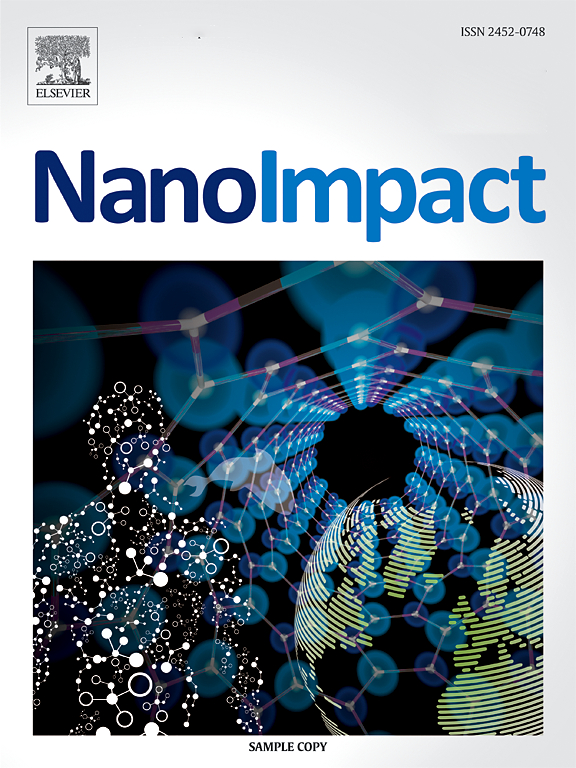天然有机物对马格纳河鼠和亚capitata河鼠MXenes (Ti3C2Tx)生态毒性、摄入和净化的影响
IF 5.5
3区 环境科学与生态学
Q2 ENVIRONMENTAL SCIENCES
引用次数: 0
摘要
二维无机先进材料MXenes (Mn+1XnTx)由于其独特的特性使其在化学和机械上稳定,具有多种应用,例如储能,水净化和光催化,因此受到了广泛的关注。虽然MXenes的性质和潜在的应用已经得到了广泛的研究,但由于其可能的广泛应用,对其潜在的生态毒理学效应还需要更多的信息。本研究的目的是评估Ti3C2Tx-MXenes对淡水藻类(Raphidocelis subcapitata)和甲壳类动物(Daphnia magna)的短期毒性,以及它们在D. magna的食入和净化研究中的生物积累行为。在不同的测试设置中研究了MXenes的生态毒性,包括暴露于含和不含化学五氯酚(PCP)和天然有机物(NOM)的水容馏分后的MXenes 24 h老化实验。总的来说,MXenes(老化和未老化)在测试浓度范围内(最高测试浓度为100 mg/L)不影响D. magna的迁移率,而影响藻类的生长(ec50值分别为81 mg/L和41 mg/L,老化和未老化)。此外,MXenes的存在不影响PCP对藻类的毒性。相比之下,水蚤试验显示,含MXenes的PCP溶液的毒性低于不含MXenes的溶液,这表明MXenes存在时PCP的生物利用度降低。在藻类试验中加入NOM可降低MXenes的毒性。此外,D. magna的摄入和净化试验表明,NOM的存在降低了微生物对MXenes的摄入。在有食物来源(藻类)存在的情况下,D. magna比在没有食物存在的情况下更快地净化了残留的MXenes。本文章由计算机程序翻译,如有差异,请以英文原文为准。
Influence of natural organic matter on ecotoxicity, ingestion and depuration of MXenes (Ti3C2Tx) in D. magna and R. subcapitata
The two-dimensional inorganic advanced materials MXenes (Mn+1XnTx) have been gaining traction due to their unique characteristics making them chemically and mechanically stable with diverse applications for, e.g., energy storage, water purification, and photocatalysis. Although the properties and potential applications of MXenes have been widely researched, a need for more information regarding the potential ecotoxicological effects of the materials remains due to their possible widespread use. The purpose of this study was to assess the short-term toxicity of Ti3C2Tx-MXenes towards the freshwater algae (Raphidocelis subcapitata) and the crustacean (Daphnia magna), as well as their bioaccumulation behaviour in ingestion and depuration studies with D. magna. The ecotoxicity of MXenes was investigated in different test setups, including a 24 h aging experiment of MXenes following exposure to the water accommodated fraction with and without the presence of the chemical pentachlorophenol (PCP) and natural organic matter (NOM). Generally, it was found that MXenes (aged and not aged) did not affect the mobility of D. magna in the concentration range tested (highest test concentration: 100 mg/L) while algal growth was affected (EC50-values of 81 mg/L and 41 mg/L, with and without aging, respectively). Furthermore, the results indicated that the presence of MXenes did not affect the toxicity of PCP towards algae. Contrastingly, daphnia tests of PCP solutions with MXenes present showed lower toxicity than solutions without MXenes, suggesting a decrease in bioavailability of PCP in the presence of MXenes. Addition of NOM to algal tests resulted in decreased toxicity of MXenes. Additionally, the ingestion and depuration tests with D. magna indicated that the presence of NOM lowered the organisms ingestion of MXenes. In the presence of a food source (algae) D. magna depurated the residual MXenes faster than in experiments where no food was present.
求助全文
通过发布文献求助,成功后即可免费获取论文全文。
去求助
来源期刊

NanoImpact
Social Sciences-Safety Research
CiteScore
11.00
自引率
6.10%
发文量
69
审稿时长
23 days
期刊介绍:
NanoImpact is a multidisciplinary journal that focuses on nanosafety research and areas related to the impacts of manufactured nanomaterials on human and environmental systems and the behavior of nanomaterials in these systems.
 求助内容:
求助内容: 应助结果提醒方式:
应助结果提醒方式:


